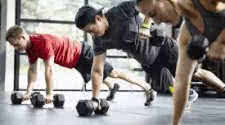Training Stress Factors: The Key Weight Training Elements for Progress

Continue with Success and Progress with your Goals
To begin, let's outline the eight training-stress factors that can help you remain in the optimal training zone, or OTZ, indefinitely if you know how to use them to best advantage: 1) workout length, 2) workout frequency, 3) bodypart training frequency, 4) exercise selection and performance, 5) rep speed, 6) workout volume and intensity, 7) poundages and reps used and 8) rest intervals between sets. Most weightlifting programs focus on a few of these variables. Trainees generally change poundages and repetitions or they try a couple of new exercises, but very few plan their routines around all eight factors. Still, the ability to manipulate all the factors in your program is fundamental to success in the sport. Next, let's begin taking an in-depth look at these key elements of training, more specifically the first crucial factors.
Workout length
It's a common misconception that longer workouts are always better. The fact is that two- to-three-hour sessions are largely a waste of time. We know this because exhaustive research Tom Platz performed in Bulgaria showed that a with Leo Costa Jr. man's natural supply of testosterone decreases by up to 80 percent after 35 to 45 minutes of rigorous weight training.Testosterone is the hormone that aids in the body's recovery and subsequent growth after a workout. When your testosterone becomes depleted, both recovery and growth are stunted.
Limiting your workouts to 45 minutes or less also lets your body effectively process glucose. This ensures optimal performance throughout the session, which leads to a higher- quality workout.
In addition, shorter workouts are easier to schedule than those marathon sessions, and they're not nearly as psychologically intimidating. This results in a more positive attitude and increased concentration. You're better off mentally and physically.
Workout frequency
Eastern-bloc research showed that the 45-minute workout offers another advantage - a much shorter recovery period In fact, athletes can be conditioned to recover in as little as two hours. That's how the Bulgarians were able to squeeze a half dozen workouts into their daily schedule. Although I'm not advocating that you take your training to the extremes the Bulgarians did, this point does show that you can work out more than once a day without fear of overtraining. Instead of worrying about over-training, worry about undertraining. Working on the edge of overtraining can help you ramp up into the hyperzone for maximum growth, while undertraining is obviously a waste of precious training time.The other side of the question has to do with how long you can rest between workouts before you start to lose muscle. Research shows that atrophy begins about 72 hours after the last stress is applied. Anyone who hopes to make bodybuilding gains certainly has to schedule his or her next workout within that time frame.
Just where you fit into that two-to-72-hour window of opportunity depends on your level of strength, stamina and general recovery ability. The Bulgarians didn't start out with seven workouts a day; they worked up to it. Unless you're a world-class athlete, five hours is about the minimum rest between workouts you should be taking.
Body-part-training frequency
As indicated above, you shouldn't wait any longer than 72 hours to get back in touch with a muscle. More than that will lead to atrophy, not a trophy. Don't depend on soreness to tell you when to train. Sore or not, muscles can and should be trained again within that 72-hour period. Other factors, such as nutrition, sleep and proper lifting technique, will enter into the frequency equation. With careful planning, however, you can train effectively much more often than you ever thought possible.Exercise selection and performance
Thousands of books and articles have been written on the subject of exercise selection. If you're like most bodybuilders, you get information from other athletes. You try the exercises, keep some, toss some and keep looking. If it's chest day and you feel like benching, you do it. Or maybe you do flys or pullovers instead. Warning: This kind of haphazard approach is a danger to your physical growth!There is a system that can help you select the most effective exercises for each bodypart, however. It's based on neuromuscular activity, and it's such an important part of weight training that I'm going to devote a whole column to it in the future.
For now let's just consider the old myth that you should always use strict form. So-called strict form lets you target muscles while reducing your chance of injury but it also causes you to use less weight than you might otherwise lift. Sometimes it pays to loosen up a little.
For example, start your set of curls with strict form. Toward the end you can use a slight bounce off your thighs and a slight lean to get the bar up. The shift from strict form is more than offset by the benefit of added weight.
Please note that I said a slight bounce and a slight lean. I also said loose form, not sloppy form. Exaggerated moves that create lots of momentum actually take the stress off the target muscle. They also increase your risk of injury. Never get into sloppy form for the sake of increased poundage.